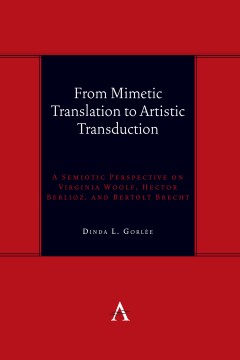From Mimetic Translation to Artistic Transduction
A Semiotic Perspective on Virginia Woolf, Hector Berlioz, and Bertolt Brecht.
By Dinda Gorlée
Other Formats Available:
- About This Book
- Reviews
- Author Information
- Series
- Table of Contents
- Links
- Podcasts
About This Book
Transduction is beyond translation: both retranslation and auto translation move beyond the transferal of one language to another to signify the speculative attempts to examine and execute the belief, concepts, and meaning of the level of different arts. The art of translating means the analytical exercise of transferring, rotating, and twisting one language into another art, but to retranslate (or auto translate) literary translation, the objective of retranslation or self-translation is to create from translation the poetic and lyrical terms of transduction. In the translation of literary language, the translator can monopolize his situation to break up language to give a different art with or without music or another tool of the critic. The new transduction gives the audience a piece of another linguistic and/or non-linguistic art in a drawing, novel, or opera.
The semiotic scholar of literature Roman Jakobson gave a literary translation of the double words and concepts of poetical hyper translation. Language can transmit verbal translation to explore new ways of inventing and thinking about writing novels, musical theater, and the other arts. Thomas A. Sebeok deconstructed the energy of translation into the duplicated genres of artistic transduction. In semiotics, transduction is a technical expression of language and non-language, involving music, theater, and other arts. Jakobson used Saussure’s theory to give a single meaning connecting the thought and sound of words, but later he followed Charles S. Peirce’s symbolic logic with a floating sensation of the double meaning of words and concepts to give different symbols to the signs. For Peirce, literary translation becomes the graphical visions of ellipsis, parabole, and hyperbole.
Language and non-language play a role in transforming translation into transduction. Ellipsis is illustrated by Virginia Woolf’s novel The Waves to give a political transformation to change Wagner’s opera, Das Rheingold. Parabole is illustrated by the two lines of thought of Hector Berlioz. He neglected his own translation of Virgil’s Aeneid, when he retranslated the vocal text to accompany the musical lyrics of his opera The Trojans. Hyperbole is demonstrated by Bertold Brecht’s auto-translation of Gay’s The Beggar’s Opera. In the cabaret theater of The Threepenny Opera, Brecht recreated his epic hyper-translation by retranslating the language of the folk speech of the German working classes with the jargon of criminal slang.
Reviews
“DindaGorlee has been a pioneer of research in intersemiotic translation for more than three decades now. In this work, she delves deeper into the topic through an in-depth analysis of Jakobson’s work on translation, enriched by insights from biosemiotic theory. Her fascinating empirical analyses of opera and drama demonstrate her theoretical insight.” -- Kobus Marais, Department of Linguistics and Language Practice, University of the Free State, South Africa.
DindaGorlée is an international renowned scholar who has done an impressive work on understanding what translation really is. Her mastery of European culture makes this new book truly fascinating. -- Jaime Nubiola,University of Navarra, Spain.
“The semiotical insight of Dinda Gorlée offers a perfect understanding, not only in literary translation, technically re-translated into self-translation or auto-translation, but now exchanged into Peirce’s transduction — an enriching milestone that Peirce offers in the last years of his life as the intellectual adventure of reflecting the three unknown thought processes. This book reflects Gorlée’s intimate look at the transducted art in the drama of politics and aesthetics. It is a rich archive to know the multiple art of transduction.” — Claudio Guerri, University of Buenos Aires, Argentina
“In her new book, Dinda Gorlée brings to fruition her special way of creative theorizing in interpretations of three major literary giants by forging an exciting trajectory on the theme of translation from Jakobson to Peirce and Sebeok, from linguistic translation to nonverbal signification, and from translation as multimodal cultural exchange to transduction as artistic mimesis.” — Horst Ruthrof, Emeritus Professor FAHA FICI, Murdoch University, Perth, Western Australia
Author Information
Dinda L. Gorlée works as a general linguist at the Wittgenstein Archives at the University of Bergen.
Series
Anthem symploke Studies in Theory
Table of Contents
1.Forked Tongues: Theory from Translation to Transduction; Exploring New Avenues of Translation; Jakobson’s Concept of Poetry in Translation; From Translation to Transduction; Sebeok’s Transduction; 2. Wave after Wave: Wagner’s Waves Eclipsed by Virginia Woolf; Play Within Play; Three Waves; Wagner’s Water Music; Virginia Woolf’s Brain Waves; 3. War and Love: The Parabolic Retranslation in Berlioz’s Opera; Berlioz’s Poetical Drama; Olympic Odyssey; Hunt and Storm; 4. The Threepenny Opera: Jakobson’s Poetics Retranslated in the Spirit of Brecht’s Work-Plays; New Tongues for Brecht’s Language; Brecht Juggling with Gay’s The Beggar’s Opera; From Speech to Criminal Slang; Epic Epilogue; Bibliography; Index
Links
Stay Updated
Information
Latest Tweets



